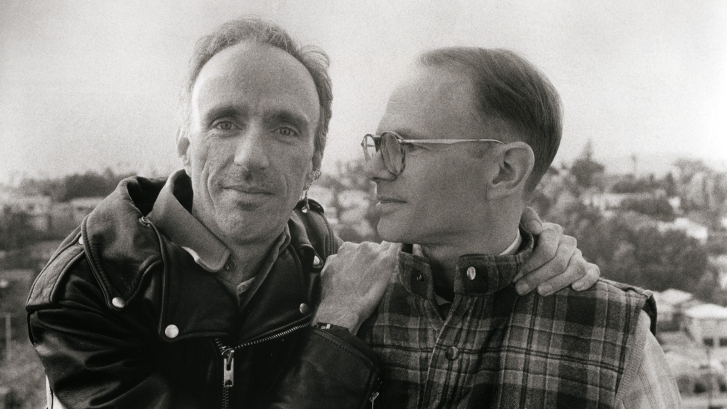Silverlake Life: The View From Here

After he was diagnosed with AIDS, film director and one-time UCLA film professor Tom Joslin decided to closely document his and his lover Mark Massi's experiences. The film follows his day to day life as he struggles to cope with the disease and its ravages. One particularly difficult section covers the lovers' journey to New Hampshire for what turns out to have been a final Christmas celebration with Joslin's family, which has kept Massi at arms-length for the twenty two years he has been Joslin's lover. As the film progresses, it becomes clear that the only factor which has made the experience at all bearable is the love between the two men. When Joslin dies, the filming continues, showing how his corpse is handled. His friend Peter Friedman continues the documentary to include the ironic aftermath of Joslin's death, in which Massi is welcomed into his lover's family.
There are no overt political statements in this documentary; it is a virtually pure record of the two men's experiences as one of them is dying. (Clarke Fountain, Rovi)
Set in the heart of Los Angeles’ Silverlake neighborhood, the film follows Joslin and Massi through
their daily triumphs and sorrows, struggling valiantly to comfort and care for each other as even the
simplest activities become excruciatingly difficult. Everyday chores, medical treatments and even a
stroll in the park require what Joslin jokingly calls “a brave effort of physical dynamism.”
Joslin, a filmmaker and instructor at the University of Southern California, had turned the camera on
himself and his family in the past. Thus Friedman, his former student, was not surprised that a super
VHS camcorder had become an observant fixture in the Joslin/Massi household.
“Making a film about Mark’s illness was a perfectly natural thing for Tom to do because as an artist,
his way of dealing with just about anything was to make a film about it,” said Friedman. “When Tom
became sick himself, he incorporated that into the film.” As each partner’s health waned, the other
picked up the baton, in what The Advocate called “a relay race between death and art.”
After Joslin died, Friedman flew to Los Angeles to begin reviewing the footage with Massi who was
alone to deal with his own worsening condition. Though committed to helping complete the film,
Massi was unable to bring himself to watch. Instead, he sat nearby, filling Friedman in on the
details. Massi died months later.
“It’s a first-person diary made by someone who wasn’t around to finish it,” explained Friedman. “And
absence is really part of what the film is about. For me, that absence symbolizes the absence of
people everywhere who aren’t where they should be, because of the devastation AIDS has brought
to this country and to the world.” (AMDOC Inc.)
>>> watch clip on videodetective.com
>>> watch trailer
details
-
Runtime
97 min -
Country
United States -
Year of Presentation
1993 -
Year of Production
1992 -
Director
Peter Friedman, Tom Joslin -
Cast
Tom Joslin, Mark Massi, Liane Bonin -
Production Company
Tom Joslin, Peter Friedman, Doug Block, Jane Weiner -
Berlinale Section
Panorama -
Berlinale Category
Documentary Film -
Teddy Award Winner
Best Documentary/ Essay Film
Biography Peter Friedman
Peter Friedman studied film at Hampshire College, where he was a student and protégé of Tom Joslin. They maintained a close friendship long after Friedman graduated and established himself as a documentary filmmaker in New York City.
Friedman received an Academy Award® nomination for directing “The Wizard of the String,” a documentary portrait of vaudeville era musician Roy Smeck, and an Emmy® nomination for editing “Flamingo Odyssey” for National Geographic. In 1990, he produced and directed “I Talk to Animals,” a portrait of an animal therapist, which was broadcast in 10 different countries.
In 1993, Friedman completed SILVERLAKE LIFE: THE VIEW FROM HERE for his mentor Joslin, who passed away during the course of filming. SILVERLAKE LIFE was called “the most honest depiction of AIDS on screen” and won the Grand Jury Prize at the Sundance Film Festival. Friedman currently resides in Paris and New York City.
“As important as Tom was to me, I didn’t undertake the sad and difficult task of completing SILVERLAKE LIFE as a personal tribute. I did it because I believe in what Tom was trying to do – to make people understand the magnitude of the suffering and loss that people with AIDS and their loved ones face, and also to show the depth of love and commitment that can exist in a gay relationship.”
-newvideo.com
Biography Tom Joslin
Tom Joslin was born on November 29, 1946 as Thomas Hancock Joslin. He was the son of Charles Sumner Joslin and Mary Hall Kimball Joslin. Tom was an independent film maker and former film teacher at UCLA. He was the husband of Mark Massi.
He is known for his work on Silverlake Life: The View from Here (1993), Black Star: Autobiography of a Close Friend (1977) and The Milagro Beanfield War (1988).
Tom and his husband Mark were both diagnosed with HIV/AIDS in the late 1980's. Silverlake Life was created in the final year of Tom's life and showed the reality of living with and dying of AIDS. The film won several awards including a 1994 Peabody Award. It shared the 1993 Grand Jury Prize at the Sundance Film Festival with the film Children of Fate: Life and Death in a Sicilian Family. The film was completed after the death of Tom and Mark by a former student of Tom's, Peter Friedman.
Silverlake Life is a testament to the horrors of AIDS before effective treatment was discoverd but it is also a beautiful love story between two men who in their deaths, educated people and put a human face to AIDS in a way only they could have.
-findagrave.com